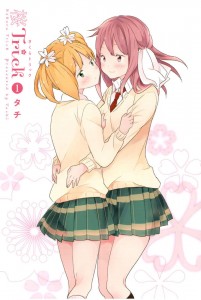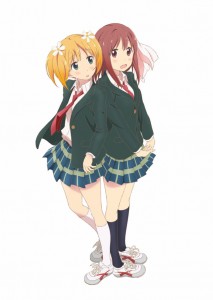You know, we talk about comics here, but I rarely talk about “Art.” This is because: 1) Interpretation of Art is absolutely personal and; 2) The art in a comic is less important to me than the story and/or where story and art intersect. This is why I separate out the Art and Story categories for my Ratings, because the one does not guarantee (or even compliment) the other in manga.
Because I am not naturally visual, I’ve relied on a lot of other people to tell me what I was seeing…and why I should care. Today on Quora, I had a chance to share my process in learning to “get” art.
What is the point of this picture by Carlos D. Donjuan? I understand that it must have something to it because a lot of people seem to like it. I just don’t “get” it. Is there a message? Does it appeal to people emotionally?

Here is my answer:
Here’s the thing about Art. Not everyone needs to resonate with every artistic endeavor.
For instance, here is a very famous work of Art that millions of people come to see from all over the world. They stand there and sigh and cry and are all sorts of emotionally moved by it:
I don’t “get” it at all. The women have male bodies with breasts. It’s allegory, which I think should not work as a guiding model for a life after 8 years old or so. People love this painting.
There all different ways a person can enjoy Art. It might speak to you personally on an emotional level. You can think it’s pretty. It can evoke a memory. You may hate it. You may admire the technique, the draftsmanship, the skill…and still not like the piece.
Art is largely subjective. The piece you used as an example means nothing to me yet. Neither did Picasso’s Guernica, until I had a chance to learn about it and really grasp what he was doing with it. I can’ say I “like” it, but I can appreciate it.
I don’t know Donjuan’s art, but I have always liked graffiti and collage as media, so I’m kindly disposed to the piece from the outset. The more I look at it, the more I like his take on portraiture. So, yes, in the time it has taken me to write this, I’ve come to a place where I “get” this piece. Here’s what he’s done. He’s taken a picture of a mother and son and…pets…maybe…

…and rendered it in collage. Both mother and son look happy, even though they have no faces. They look comfortable with each other and their environment – an environment that is…water? They appear to be chest deep in water.
And oh, look, there is a halo around the child’s head. This is not a “mother and son” this is a Madonna and Child picture. The “pets” are the Evangelists, I’ll venture. And the water is meant to evoke the Baptism, at a guess.

So, yes…I “get” this painting now. And I don’t dislike it, although I’m not moved by the theme.
***
What does that have to do with manga, you ask? It has everything to do with “understanding” what you see and what you read here. Right now, I’m reading Sakura Trick, Volume 1 (桜トリック), in preparation for the upcoming anime.
Here is the manga art:

What can you tell about the series from the picture? Well, right away, we can see it is a school-life romance, so we can guess there will be nothing ground-breakingly new here. But, we can also see that the relationship is consensual…and as this is the first page of the book, we have to presume that the relationship is established either before the book starts or early on. Why do I say that? Because if the relationship is the climax of the story, the first page gives it away.
If we look at the publisher of the manga, we can see that is published by KR Comics. We then know it is very likely a gag comic strip, because that is what they specialize in.
When we look at the anime art, we can see that, if anything, the character designs have been simplified.

We are not yet given any backgrounds, but it seems likely, as it is a gag series that focuses on schoolgirls and the art is simple, rather than realistic, that we’re looking at something rather like Yuri Yuri than, say, Strawberry Panic. If you said to yourself just now, “Yeah, I knew that,” you already understand some of the conventions and tropes of manga art.
(As an aside, based on all this, I am looking for someone else to consider reviewing the anime for me, since I can tell that it probably will not be my cup of tea. ^_^)
What does it mean when a manga page has a black border and background around the panels? Do you instantly realize that this is a visual indicator of a “flashback?” Then you “understand” this visual cue, probably without realizing it. Certain kinds of motion and speed indicators are almost universal, as well, – think of the visual convention for “scuffle” – a cloud with random body parts and items protruding at random angle and motion lines.
Understanding art is about context. It is up to the artist to initially supply the context or the reader may just never have any idea what is going on. Genre checklists shortcut that process. Evil eyebrows and big-ass swords are indicators of personality and motivation…and skills.
If you pick all this up without explanation, that’s great, but if you’re out there wondering what the heck everyone sees in a particular manga, you’re not alone.
When you next look at at a picture or series that makes no sense to you, you can of course, just slide past it and give it no more of your time – or, you can slow down and see if you can “understand” it. ^_^
If you have any questions about manga visual conventions and tropes – or you just want to wax poetic or complain about a visual indicator you like or love, hit us up in the comments!
![]() I am not a Brony. Not even a Lesbrony. I’m not saying I’m above slashing children’s cartoon characters, because clearly I am not. (I vaguely regret not writing that Dark Cure x Cure Moonlight x Momoka fanfic that flitted through my mind from time to time while I had the energy.)
I am not a Brony. Not even a Lesbrony. I’m not saying I’m above slashing children’s cartoon characters, because clearly I am not. (I vaguely regret not writing that Dark Cure x Cure Moonlight x Momoka fanfic that flitted through my mind from time to time while I had the energy.)






